 Problems with New York's new electronic voting system are being reported across the state today, according to the New York Times. Today's primary elections mark the first statewide use of the new, paper-based optical-scan systems which have been been the cause of much controversy among election officials and Election Integrity advocates over the last several months and years in the Empire State.
Problems with New York's new electronic voting system are being reported across the state today, according to the New York Times. Today's primary elections mark the first statewide use of the new, paper-based optical-scan systems which have been been the cause of much controversy among election officials and Election Integrity advocates over the last several months and years in the Empire State.
New York is the last state in the union to replace their older election system --- much of the state, as well as all of New York City had previously used mechanical lever machines --- with new-fangled, failure-prone, easily-manipulated computerized systems following the federal Help America Vote Act (HAVA) of 2002 which was enacted in the wake of the 2000 Presidential Election debacle.
In New York City, where Wall Street Journal reports the problems are "most severe" --- including reports from Mayor Bloomberg on "reports of broken and missing scanners, poor customer service and poll sites opening two to four hours late" --- the new systems are made by ES&S, the nation's largest voting machine company, and one with a storied history of election failures.
The systems used in other parts of the state are largely manufactured by the Canadian firm Dominion Voting, formerly as a partnership with Sequoia Voting Systems. Dominion eventually bought out cash-strapped Sequoia's portion of the NY state deal before buying out Sequoia entirely earlier this year. The purchase of Sequoia, then the nation's third-largest e-voting firm, on the heels of their purchase of Diebold/Premiere just weeks prior, has vaulted Dominion, virtually overnight, to one of the largest e-voting vendors in the U.S..
[Read The BRAD BLOG's recent exclusive on the Dominion purchase of Sequoia, and their attempts to cover up the continuing relationship that Sequoia has with a Venezuelan firm tied to President Hugo Chavez.]
Some state election officials and Election Integrity advocates alike had long-warned against the implementation of these new systems, going so far as to take the issue to court and to testify to the inability of certifying the accuracy of elections run on the new machines.
According to the Times this morning, some polling places "did not open for more than 90 minutes" in Brooklyn; elsewhere, every ballot scanned "was returning a the 'system error'" message; and across the state, there have been reports of "longer-than-usual delays and troubles with the scanners that are supposed to swallow and tabulate the new, SAT-style ballots"...
As reported by the Times today:
Some polling places in Brooklyn did not open for more than 90 minutes — and there was one report of a three-and-a-half hour delay — as election workers tried to get the new equipment to function. Senator Charles E. Schumer was held up when he arrived at Public School 321 in Park Slope just before the scheduled 6 a.m. opening: He and other voters had to wait 15 to 20 minutes before the machines were ready to take their ballots.
Even at polling places where the new machines seemed to operate correctly, it was slow going. At Public School 165, on 109th Street between Broadway and Amsterdam Avenue, 80 people waited in a long line, waiting to feed the ballots they had filled out into the machine. At least one frustrated voter tried to bail out and throw his ballot in a wastebasket, though an election worker told him not to — it was against the rules.
Some voters were unhappy about having to give the completed ballot to election workers running the scanning device. “That’s not a secret ballot at that point,” said Paul Randour, 75, a retired lawyer who voted on East 79th Street in Manhattan. He insisted on inserting his ballot into the machine himself.
Empire Staters had the honor today of being among the last in the union to note:
And there's this democracy-inspiring note from the NYT's report [emphasis added]:
The poll worker told Mr. Rojas not to worry; every ballot was generating the “system error.”
“Presumably the thing was actually tallied and the system error pertained to something else — that’s what the poll worker was saying,” Mr. Rojas said. “But it didn’t exactly inspire confidence in the whole system.”
Setting aside the "system error" on "every ballot", the most disturbing point in the above may be what we've been trying to warn the world about here at The BRAD BLOG for years: "Presumably the thing was actually tallied".
There is, of course, no way to know if "the thing was actually tallied", without actually bothering to count paper ballots by hand to know for certain, thus defeating the general point of using these horrible systems in the first place.
All of this, of course, could have been avoided, as New York Election Integrity advocates --- as well as a number of election officials --- have been fighting against the adoption of the new systems, after similar systems have racked up a disturbing record of failure across the nation since HAVA encouraged their implementation.
Some of the EI advocates in NY, such as New Yorkers for Verified Voting, had focused over the years on ensuring the state didn't make an even worse choice by moving from levers to 100% unverifiable Direct Recording Electronic (DRE, usually touch-screen) voting systems after the U.S. Dept. of Justice had threatened to sue the state for not moving quickly enough to provide a voting system that could be used privately and independently by disabled voters, as per HAVA.
While the fight was won to choose optically-scanned paper ballots rather than unverifiable electronic DRE "ballots", a campaign was waged by other advocates to keep NY's mechanical lever system, which has been used there for decades, in place. Court battles continue on that front, and problems in today's election will no doubt come into play in that law suit.
One election official, Columbia County's Virginia Martin reportedly stunned a State Assembly panel last year when she testified that she'd not be able to certify the accuracy of her county's elections unless paper ballots were 100% hand-counted.
"The mandated transition to electronic voting and vote-counting will likely prevent me as commissioner from doing my job, which is to certify to the accuracy of election numbers," Martin told the state's Standing Committee on Election Law last October in New York City.
Martin was said to have praised the attempt to provide accessibility to disabled voters, but warned the new computerized systems have too many problems, including a propensity to break down on Electoin Day.
She stated, at the time, "if Columbia County starts using software to count votes, I will not certify an election unless an appropriately designed audit of the paper ballots is conducted."
State EI advocates have informed The BRAD BLOG that Columbia plans to lock all scanned paper ballots in a county jail cell before performing a 100% hand count of all races on the day following Election Day in order "to avoid relying on the software."
 The Dominion/Sequoia systems being used across the state today were first partially deployed in the state last November during the hotly contested Special Election for the U.S. House in NY's 23rd Congressional District. In that election --- which we covered in some detail for Upstate NY's right-leaning Gouverneur Times (see here and here) --- Conservative Party candidate Doug Hoffman reportedly lost in a very close race to the Democratic candidate Bill Owen. The Dominion/Sequoia op-scan systems failed in a number of precincts across several counties during that election, which Hoffman made the mistake of conceding far too early, leaving thousands of paper ballots uncounted by any human being.
The Dominion/Sequoia systems being used across the state today were first partially deployed in the state last November during the hotly contested Special Election for the U.S. House in NY's 23rd Congressional District. In that election --- which we covered in some detail for Upstate NY's right-leaning Gouverneur Times (see here and here) --- Conservative Party candidate Doug Hoffman reportedly lost in a very close race to the Democratic candidate Bill Owen. The Dominion/Sequoia op-scan systems failed in a number of precincts across several counties during that election, which Hoffman made the mistake of conceding far too early, leaving thousands of paper ballots uncounted by any human being.
Without bothering to count ballots by hand, optical-scan machines can be maliciously programmed to flip election results without detection, as demonstrated in the stunning finale of HBO's Emmy-nominated 2006 documentary Hacking Democracy. You can watch that hack here as it occurred live in Leon County, Florida on a Diebold/Premier optical scan system. Dominion purchased both Diebold/Premier and Sequoia earlier this year, making the Canadian firm one of the largest e-voting companies in the nation along with their top competitor, the oft-failed ES&S whose systems are being used for the first time today in New York City.
CORRECTION: We had originally indicated that the new voting systems in New York City were made by Dominion/Sequoia. Those systems are made by ES&S. The article above has been corrected to that end.
UPDATE: NY news site "Politics on the Hudson" reports on problems with some of the Dominion/Sequoia ImageCast op-scanners in Westchester County, including the ones used by Bill O'Reilly's wife. In a follow-up item they note "After reports of faulty voting machines in New York City and the rest of the state today, [State] Comptroller Thomas DiNapoli offered to look into the problem."
Wall Street Journal has many more details on the mess in New York City.
ComputerWorld has more on probs in NYC as well as Westchester and Nassau Counties.


 Judge Dismisses Long-Running Challenge to GA's Unverifiable, Insecure E-Vote System: 'BradCast' 4/1/25
Judge Dismisses Long-Running Challenge to GA's Unverifiable, Insecure E-Vote System: 'BradCast' 4/1/25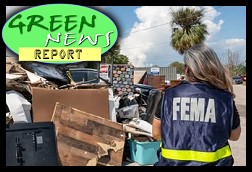 'Green News Report' 4/1/25
'Green News Report' 4/1/25
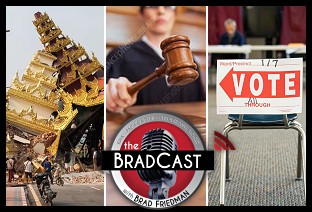 Bad Court and Election News for Trump is Good News for America: 'BradCast' 3/31/25
Bad Court and Election News for Trump is Good News for America: 'BradCast' 3/31/25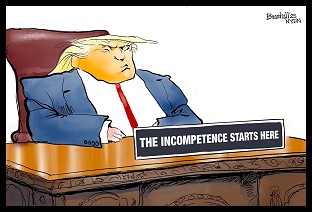 Sunday 'Great Start!' Toons
Sunday 'Great Start!' Toons Vets Push Back at Trump, Musk Plan to Slash Health Care, 80K V.A. Jobs: 'BradCast' 3/27/25
Vets Push Back at Trump, Musk Plan to Slash Health Care, 80K V.A. Jobs: 'BradCast' 3/27/25 'Green News Report' 3/27/25
'Green News Report' 3/27/25 Signal Scandal Worsens for Trump, GOP; Big Dem Election Wins in PA: 'BradCast' 3/26
Signal Scandal Worsens for Trump, GOP; Big Dem Election Wins in PA: 'BradCast' 3/26 'Emptywheel' on Why Trump NatSec Team Should 'Resign in Disgrace' After Signal Chat Debacle: 'BradCast' 3/25/25
'Emptywheel' on Why Trump NatSec Team Should 'Resign in Disgrace' After Signal Chat Debacle: 'BradCast' 3/25/25 'Green News Report' 3/25/25
'Green News Report' 3/25/25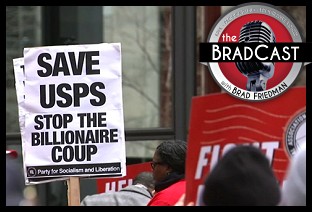 USPS 'Belongs to the People, Not the Billionaires': 'BradCast' 3/24/25
USPS 'Belongs to the People, Not the Billionaires': 'BradCast' 3/24/25 Sunday 'Suddenly Conceivable' Toons
Sunday 'Suddenly Conceivable' Toons 'Green News Report' 3/20/25
'Green News Report' 3/20/25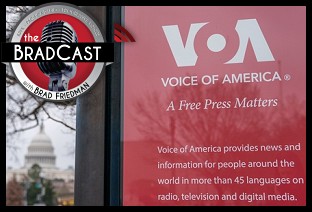 We're ALL Voice of America Now: 'BradCast' 3/20/25
We're ALL Voice of America Now: 'BradCast' 3/20/25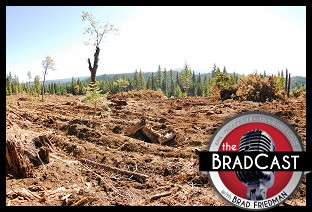 What Trump's 'Timber Production Expansion' Means (and Costs): 'BradCast' 3/19/25
What Trump's 'Timber Production Expansion' Means (and Costs): 'BradCast' 3/19/25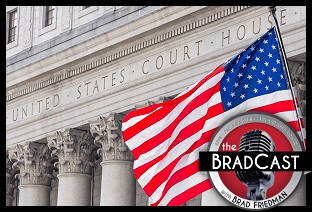 Courts Largely Holding Against Trump, Musk Lawlessness: 'BradCast' 3/18/25
Courts Largely Holding Against Trump, Musk Lawlessness: 'BradCast' 3/18/25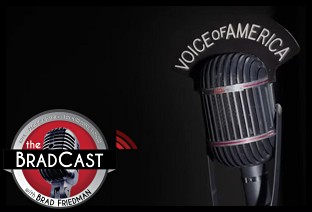 Chief VOA Reporter on Outlet Falling Silent First Time Since 1942: 'BradCast' 3/17/25
Chief VOA Reporter on Outlet Falling Silent First Time Since 1942: 'BradCast' 3/17/25 Trump EPA Unveils Plans to Endanger, Sicken Americans: 'BradCast' 3/13/25
Trump EPA Unveils Plans to Endanger, Sicken Americans: 'BradCast' 3/13/25 Trump Nixed Enforce-ment Against 100 Corp. Lawbreakers: 'BradCast' 3/12/25
Trump Nixed Enforce-ment Against 100 Corp. Lawbreakers: 'BradCast' 3/12/25 Bad Day for 'Strongmen': 'BradCast' 3/11
Bad Day for 'Strongmen': 'BradCast' 3/11 WI Election Could Flip Supreme Court Control, Musk Jumps In: 'BradCast' 3/10
WI Election Could Flip Supreme Court Control, Musk Jumps In: 'BradCast' 3/10
 VA GOP VOTER REG FRAUDSTER OFF HOOK
VA GOP VOTER REG FRAUDSTER OFF HOOK Criminal GOP Voter Registration Fraud Probe Expanding in VA
Criminal GOP Voter Registration Fraud Probe Expanding in VA DOJ PROBE SOUGHT AFTER VA ARREST
DOJ PROBE SOUGHT AFTER VA ARREST Arrest in VA: GOP Voter Reg Scandal Widens
Arrest in VA: GOP Voter Reg Scandal Widens ALL TOGETHER: ROVE, SPROUL, KOCHS, RNC
ALL TOGETHER: ROVE, SPROUL, KOCHS, RNC LATimes: RNC's 'Fired' Sproul Working for Repubs in 'as Many as 30 States'
LATimes: RNC's 'Fired' Sproul Working for Repubs in 'as Many as 30 States' 'Fired' Sproul Group 'Cloned', Still Working for Republicans in At Least 10 States
'Fired' Sproul Group 'Cloned', Still Working for Republicans in At Least 10 States FINALLY: FOX ON GOP REG FRAUD SCANDAL
FINALLY: FOX ON GOP REG FRAUD SCANDAL COLORADO FOLLOWS FLORIDA WITH GOP CRIMINAL INVESTIGATION
COLORADO FOLLOWS FLORIDA WITH GOP CRIMINAL INVESTIGATION CRIMINAL PROBE LAUNCHED INTO GOP VOTER REGISTRATION FRAUD SCANDAL IN FL
CRIMINAL PROBE LAUNCHED INTO GOP VOTER REGISTRATION FRAUD SCANDAL IN FL Brad Breaks PA Photo ID & GOP Registration Fraud Scandal News on Hartmann TV
Brad Breaks PA Photo ID & GOP Registration Fraud Scandal News on Hartmann TV  CAUGHT ON TAPE: COORDINATED NATIONWIDE GOP VOTER REG SCAM
CAUGHT ON TAPE: COORDINATED NATIONWIDE GOP VOTER REG SCAM CRIMINAL ELECTION FRAUD COMPLAINT FILED AGAINST GOP 'FRAUD' FIRM
CRIMINAL ELECTION FRAUD COMPLAINT FILED AGAINST GOP 'FRAUD' FIRM RICK SCOTT GETS ROLLED IN GOP REGISTRATION FRAUD SCANDAL
RICK SCOTT GETS ROLLED IN GOP REGISTRATION FRAUD SCANDAL VIDEO: Brad Breaks GOP Reg Fraud Scandal on Hartmann TV
VIDEO: Brad Breaks GOP Reg Fraud Scandal on Hartmann TV RNC FIRES NATIONAL VOTER REGISTRATION FIRM FOR FRAUD
RNC FIRES NATIONAL VOTER REGISTRATION FIRM FOR FRAUD EXCLUSIVE: Intvw w/ FL Official Who First Discovered GOP Reg Fraud
EXCLUSIVE: Intvw w/ FL Official Who First Discovered GOP Reg Fraud GOP REGISTRATION FRAUD FOUND IN FL
GOP REGISTRATION FRAUD FOUND IN FL


































